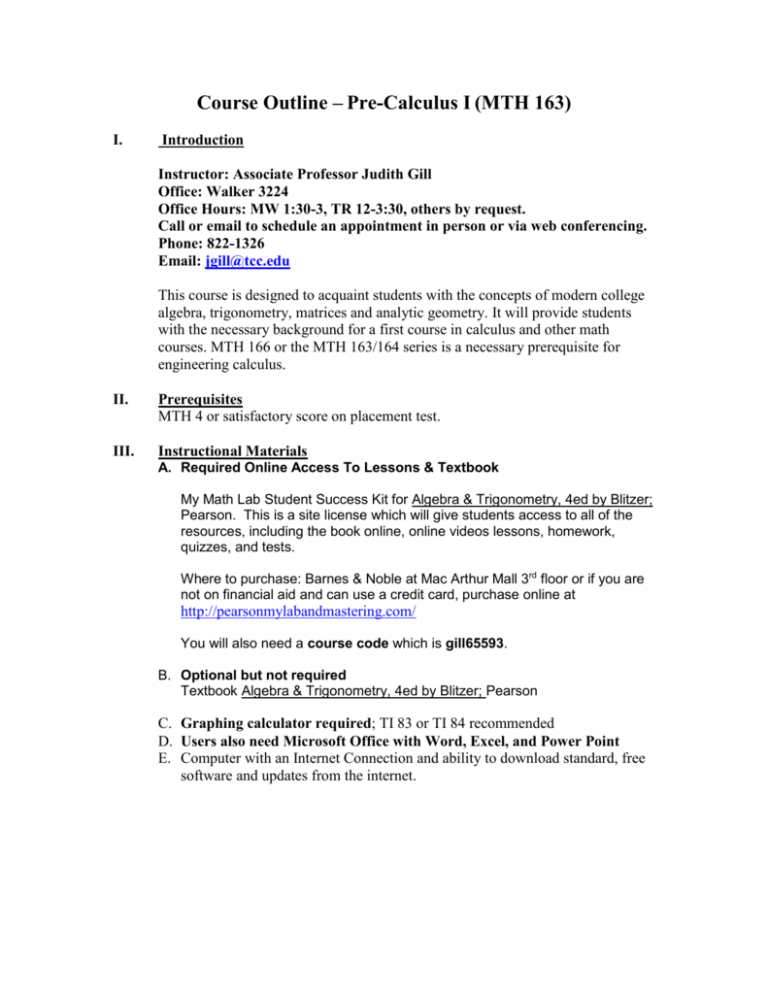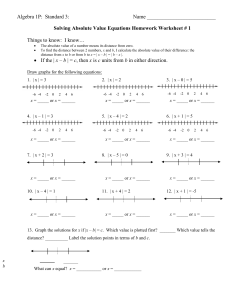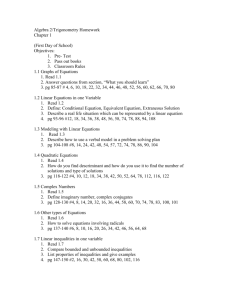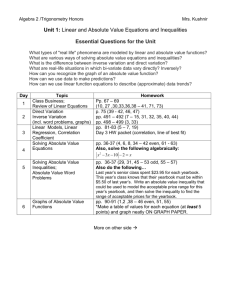Course Outline – Applied Calculus (MTH 270)
advertisement

Course Outline – Pre-Calculus I (MTH 163) I. Introduction Instructor: Associate Professor Judith Gill Office: Walker 3224 Office Hours: MW 1:30-3, TR 12-3:30, others by request. Call or email to schedule an appointment in person or via web conferencing. Phone: 822-1326 Email: jgill@tcc.edu This course is designed to acquaint students with the concepts of modern college algebra, trigonometry, matrices and analytic geometry. It will provide students with the necessary background for a first course in calculus and other math courses. MTH 166 or the MTH 163/164 series is a necessary prerequisite for engineering calculus. II. Prerequisites MTH 4 or satisfactory score on placement test. III. Instructional Materials A. Required Online Access To Lessons & Textbook My Math Lab Student Success Kit for Algebra & Trigonometry, 4ed by Blitzer; Pearson. This is a site license which will give students access to all of the resources, including the book online, online videos lessons, homework, quizzes, and tests. Where to purchase: Barnes & Noble at Mac Arthur Mall 3rd floor or if you are not on financial aid and can use a credit card, purchase online at http://pearsonmylabandmastering.com/ You will also need a course code which is gill65593. B. Optional but not required Textbook Algebra & Trigonometry, 4ed by Blitzer; Pearson C. Graphing calculator required; TI 83 or TI 84 recommended D. Users also need Microsoft Office with Word, Excel, and Power Point E. Computer with an Internet Connection and ability to download standard, free software and updates from the internet. IV. Instructional Strategies A variety of instructional strategies will be employed in addition to online discussions in Blackboard. These include, but are not limited to, group activities online and online tests. V. Attendance Policy Mathematics is a comprehensive subject and builds on itself. You are responsible for reading the sections covered in each class, and doing the assignments as listed in the syllabus. You will be required to make two visits to a proctored testing center for test taking. The first time is for Test 3 and the second time is the Cumulative Final Exam. See Weekly Schedule for the window of dates. Both will be held in TCC Testing Centers. If you are unable to get to campus, please make arrangements at least one week ahead of time for proctored testing with an Education Officer or other official Testing Center in your area. Make sure the proctor contacts your instructor at least one week ahead of time! Tests 1, 2, 4, and 5 will be taken online during a window of dates. Please make arrangements now, if necessary, to be available during those windows. Unexcused absences will result in a grade of 0 and failure of the course. Excused absences may make up the test by making arrangements with your Instructor. If unable to find a time, the final exam grade will replace the missing grade. Students who are at a great distance (50+miles) from campus are responsible to find a proctored location where someone of authority can administer their test and give them access to a computer with an internet connection. Possible places are other community colleges, or libraries. The name, address, phone number, and official title of the Proctor must be included in an email from the Proctor sent to the Instructor in plenty of time for verification and arrangements to be made. Please allow at least 5-7 days before the test. More than 20% absence of the class sessions for the semester constitutes unsatisfactory attendance and will place you in jeopardy of being withdrawn from class. In an online class, this would mean that there is no evidence of your working in the course because homework, and/or tests are not completed and discussion board is not being used. A good rule of thumb is you are in danger of being withdrawn if you do no work for 10 days or more. There is a separate withdrawal policy concerning the first week of classes. Please refer to the Weekly Schedule for more information. VI. Supplemental Notebook I recommend that you keep a 3-ring notebook to insert materials and keep your Course Outline and Weekly Schedule available. VII. Disabilities Services Policy All students will be treated with respect to their individual needs. If you are receiving services related to a disability or medical condition, or feel you might need services, please make an appointment to talk to me. Any information about 2 your disability or medical condition we discuss is confidential and will not be shared with anyone. For additional assistance, please contact your disability services counselor or the District Coordinator at 822-1213, and/or visit the web page at http://www.tcc.edu . Reasonable accommodations will be made for students with disabilities, provided that those students have registered with the Office of Disability Services. Please present me with the documentation. VIII. Grading System For a grade of A you will need to earn 90-100% For a grade of B you will need to earn 80-89% For a grade of C you will need to earn 70-79% For a grade of D you will need to earn 60-69% below 60% results in grade of F. Tests and Other Grades 10% Test 1 online 10% Test 2 online 15% Test 3 proctored 10% Test 4 online 10% Test 5 online 20% Cumulative Final Exam proctored 10% Group Assignment on MyMathLab 5% Participation on Discussion Board on MyMathLab 10% Homework on MyMathLab There are videos associated with each section. These videos are where you will receive much of your instruction. The videos are not graded so if a section is review, you may skip the video and only watch it if you feel it is necessary. The videos are only the beginning of the instruction in an online class. Each HW problem has a set of Learning Aids associated with it. They are in the form of buttons next to each problem. These Learning Aids are another mode of instruction in an online class. Feel free to use these Learning Aids as much as you like. They will not reduce your grade in any way. You may work each HW problem up to three times so there is no reason to get any grade other than 100% on HW. Remember, there are no Learning Aids available during tests so make sure you can work the problems without Learning Aids by the time you take the tests. It is a good idea to take the Practice Tests without the help of Learning Aids if possible. HW Due Dates: Following the HW pacing that is outlined in the Weekly Schedule will give you the best chance of success in this class. Please note that all HW assignments must be completed by the last day of the testing window of each corresponding test. 3 Discussion Board: You will need to post one math-related question or answer each week on the Discussion Board on MyMathLab. This is worth 5% of your grade so don’t ignore this requirement. More details are on the Discussion Board on MyMathLab. Group Assignment: A Group Assignment will be announced around mid-term. The groups will be defined in your Blackboard site and you only need to click on the Groups button and then on the underlined group name to access the various modes of communication primarily the Group Discussion board. IX. Computer Meltdown Students are responsible for maintaining their computer equipment and if a problem cannot be fixed immediately, they are required to report it to their instructors and to come to the Math Lab in room 3205 or use an alternate computer to work until their equipment is working properly. Please make sure your computer meets the system requirements as listed on the welcome page. If not, you may need to plan to attend the math lab in room 3205 to keep yourself up to date. If you have extenuating circumstances, please contact your instructor for a possible alternate schedule for catching up and completion of lessons. X. Chapter Contents Covered A. Equations and inequalities (Ch 1) 1.1 1.2 1.3 1.4 1.5 1.6 1.7 B. Functions and graphs (Ch 2) 2.1 2.2 2.3 2.4 2.5 2.6 2.7 2.8 C. Graphs and graphing utilities Linear equations and rational equations Models and applications Complex numbers Quadratic equations Other types of equations Linear inequalities and absolute value inequalities Basics of Functions and Their Graphs More on Functions and Their Graphs Linear Functions and Slope More on Slope Transformations of Functions Combinations of Functions; Composite Functions Inverse functions Distance and Midpoint Formulas; Circles Polynomial and rational functions (Ch 3) 3.1 3.2 Quadratic Functions Polynomial Functions and Their Graphs 4 3.3 3.4 3.5 3.6 3.7 D. Exponential and logarithmic functions (Ch 4) 4.1 4.2 4.3 4.4 4.5 E. Dividing Polynomials; Remainder and Factor Theorems Zeros of Polynomial Functions Rational Functions and Their Graphs Polynomial and Rational Inequalities Modeling Using Variation Exponential Functions Logarithmic Functions Properties of Logarithms Exponential and Logarithmic Equations Exponential Growth and Decay; Modeling Data Systems of equations and inequalities (Ch 8 and 9.1) 8.1 8.2 9.1 8.4 8.5 Systems of Linear Equations in Two Variables Systems of Linear Equations in Three Variables Matrix Solutions to Linear Systems Systems of Nonlinear Equations in Two Variables Systems of Inequalities For exact subsections, go to the Weekly Schedule, print and keep handy. 5







